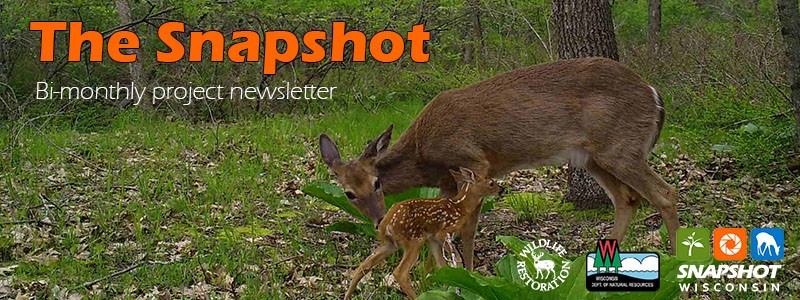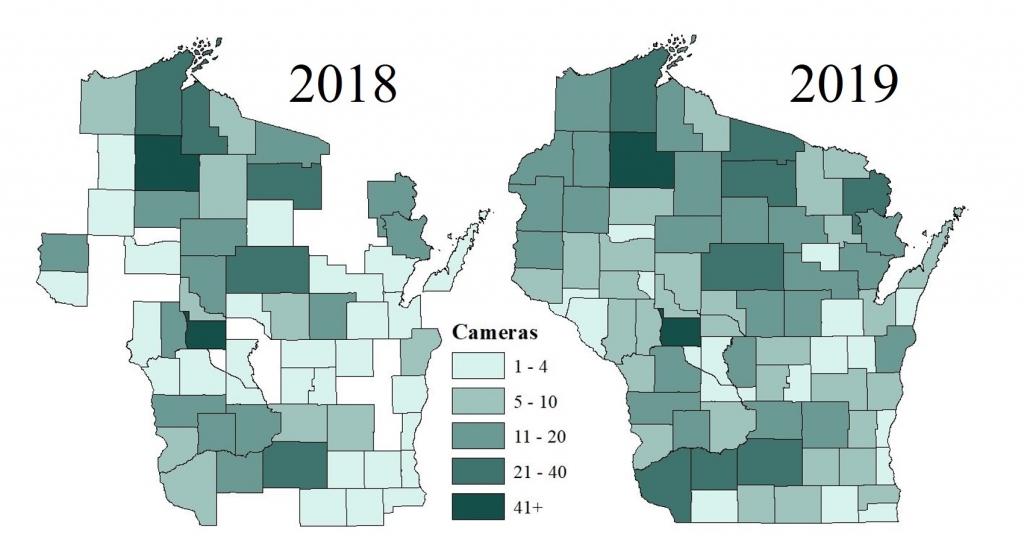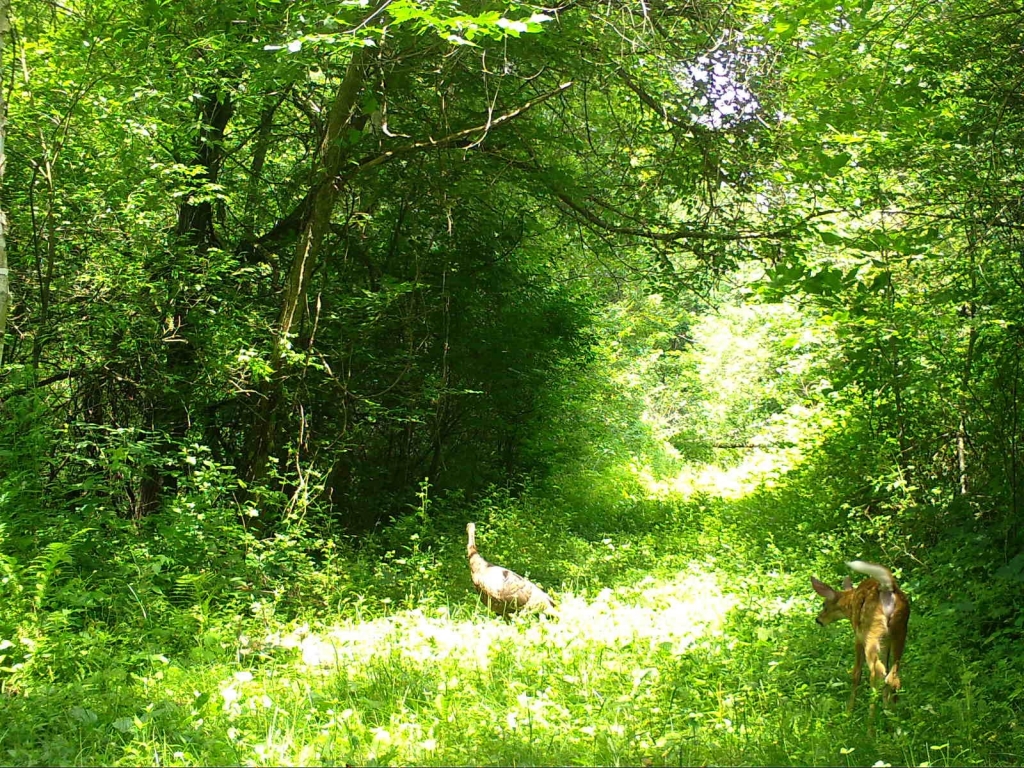The Snapshot April 2020

Translating Trail Camera Images into Deer Population Metrics
How the white-tailed deer showing up in front of your trail camera are playing a role in the management of Wisconsin’s herd.
Connections Across Volunteer Opportunities: An Interview with Al
An interview with Al Hofacker who wears many hats when it comes to his involvement in Wisconsin wildlife, including hosting a Snapshot Wisconsin camera and holding a seat on the Marinette County CDAC.
Rare Species Sighting
Another species has joined the list of rarities captured on Snapshot Wisconsin trail cameras.
Announcements
Enjoy Wisconsin wildlife from home, keeping up with Wisconsin wildlife through our blog, and April’s photo of the month.
Translating Trail Camera Images into Deer Population Metrics
The sight of deer fawns and their mothers along roadsides and in fields may be a sign to some that summer has arrived in Wisconsin. For an ecologist, fawns represent the new “recruits”, or the number of individuals that are added the deer population each year. Understanding the number of fawns on the landscape is an essential part of estimating the size of the deer herd in Wisconsin. Since launch of Snapshot Wisconsin, trail camera photos have played an increasingly important role in this process.
Fawn-to-doe ratios, along with information collected from harvested animals, are the primary way the Wisconsin DNR determines the size of the deer population prior to harvest. Simply put, a fawn-to-doe ratio is the average number of fawns produced per adult doe. This important metric varies across the state and year to year. The number of fawns produced per doe can depend on food availability, winter severity and resource competition, among other factors. For example, cold temperatures and deep snow in a given year can be difficult on the health of does, resulting in fewer fawns come spring. Southern Wisconsin farmland, on the other hand, provides good food sources for deer, and fawn-to-doe ratios are typically higher in these regions compared to northern forested areas.
Traditional surveys used to gather information about fawns and does, such as roadside observations, can have limitations due to factors like weather, topography, or time. Snapshot Wisconsin helps fill critical gaps by contributing additional data and providing improved spatial coverage. Eric Canania, Southern District Deer Biologist with the Wisconsin DNR, explained, “Snapshot’s camera coverage differs from traditional [fawn-to-doe ratio] collection methods by allowing access to observations within the heart of private lands… Although the state of Wisconsin boasts a fair amount of public land, the primary land type is still in private ownership. This means that it’s very important for us to provide [fawn-to-doe ratio] values that come from private and public lands alike and can be collected in various habitat [and] cover types.” In 2019, Snapshot Wisconsin data contributed fawn-to-doe ratios in every single county — the first time this has happened since Snapshot Wisconsin’s launch. In fact, 2019 marks a 50% increase in data collection by Snapshot trail camera volunteers compared to the previous year.
To calculate fawn-to-doe ratios, researchers look across all photos at a given camera site during the months of July and August. Having already survived the first few weeks of life in early summer, fawns seen in these months have made it through the riskiest time in their lives. July and August are also ideal for detecting fawns. They are no longer hiding from predators but instead moving around at the heel of their mother. Their characteristic spots also make them easily distinguishable from yearling or adult deer. With the critical help of volunteers, researchers identify and count all photos with does and/or fawns in them from a given camera. They then divide the average number of fawns in these photos by the average number of does. This accounts for the fact that the same doe and fawn(s) may pass in front of the same camera many times throughout the summer months. Averaging all the data from across a county, researchers can report a Snapshot Wisconsin fawn-to-doe ratio.
Fawn-to-doe ratios and population estimates are key metrics provided to Wisconsin’s County Deer Advisory Councils (CDACs). “CDACs are responsible for making deer management recommendations [to the Department] within their individual county,” explained Canania. In this way, “Snapshot provides an awesome opportunity for Wisconsin’s public to become involved and help us produce the most accurate deer management data possible.”
Connections Across Volunteer Opportunities: An Interview with Al
Like many of our state’s residents, Snapshot Wisconsin trail camera host, Al from Marinette County, wears many hats when it comes to his involvement in Wisconsin wildlife. “I’ve been interested in wildlife since childhood, and I’ve been deer hunting for 50 years.” Al shared in an interview with the Snapshot Wisconsin staff, “[Volunteering with Wisconsin DNR] is one way for me to give back a little something, by being on committees or participating in research projects.” Al’s background meant that he was no stranger to trail cameras when he enrolled in the project, which holds true for many of Snapshot Wisconsin’s volunteers.
Back when the Snapshot Wisconsin project was only enrolling volunteers in a subset of counties, Al signed on to the waitlist for Marinette County and received one of the very first cameras deployed in northeastern Wisconsin. Al joked that if you can think of a species, it has passed in front of his trail camera. His site is frequented by many deer and bear but also joined by a larger variety including bobcats, skunks, porcupines, and more. In fact, one of his favorite memories involved spotting a sow and her two cubs as he approached his camera for a routine check.
In addition to monitoring a trail camera in Marinette County, Al has served on his local County Deer Advisory Council since the program’s inception in 2014, where he is currently the hunt/conservation club representative. Al’s history as a co-chair for the Northeastern Wisconsin Rocky Mountain Elk Foundation made him a perfect selection for this seat. In the same year that Al joined the Marinette County CDAC, he also decided to enroll his 400 acres of land in the Deer Management Assistance Program.
Just as wildlife serves as a connection between Wisconsin residents, Al is able to see the connection between the different programs that he volunteers his time for. Monitoring both a Snapshot Wisconsin trail camera and being a member of his local CDAC means that his data is making a full circle back to him, especially regarding fawn-to-doe ratios. Al shared, “Our CDAC pays close attention to all the deer metrics and is especially interested in fawn-to-doe ratios.”
Rare Species Sighting
Confirmed cougar captured on a Waupaca County trail camera.
Another species has joined the list of rarities captured on Snapshot Wisconsin trail cameras, a cougar from Waupaca County. The image was confirmed as containing a cougar by the Wisconsin DNR Wildlife Management team, who have confirmed other rare Snapshot Wisconsin species, including moose, American marten and whooping crane.
Cougars once roamed the landscapes of Wisconsin, and while there have been several verified sightings in recent years, there is currently no evidence of a breeding population. Biologists believe that cougars spotted in Wisconsin belong to a breeding population from the Black Hills of South Dakota.
This sighting brings Wisconsin’s number of confirmed cougars for this year to a total of three, with the other sightings being reported from trail cameras in Price and Portage Counties. Tom, who initially identified the cougar on this Snapshot Wisconsin trail camera, shared, “[I’m] glad to have been part of it and hope to find something interesting in front of my camera again in the future.”
Announcements
See what wildlife the Snapshot Wisconsin project is capturing beyond your own trail camera. Visit www.SnapshotWisconsin.org [exit DNR]to view and classify images collected by volunteers across the state. Other fun activities to do from home are to catch up with the Snapshot Wisconsin blog [exit DNR]), learn more about rich history of phenology tracking in Wisconsin [exit DNR] or explore the surprising combinations of species [exit DNR] captured on Snapshot Wisconsin trail cameras.
April’s Photo of the Month comes from Iowa County. Trail camera host Douglas shared that this image, “captures the curiosity of the young deer.” We want to see your favorite images! Send along your favorite, funniest, or most surprising photos to the Snapshot Wisconsin team for a chance to be featured in our newsletter. To submit an image, email the picture to DNRSnapshotWisconsin@Wisconsin.gov with the subject line “Photo of the Month” and a brief description of the photo.









